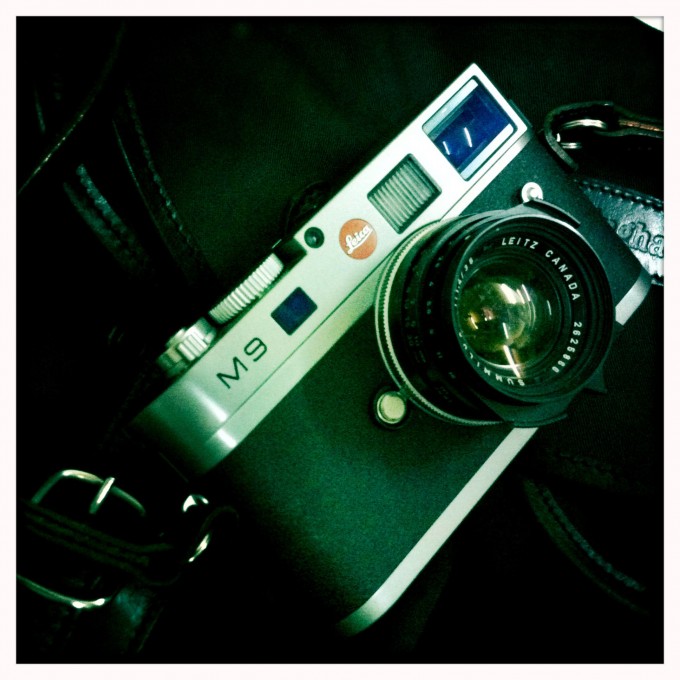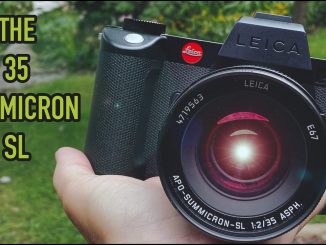A Leica 35 Summilux Classic Lens Review
By Kai Man Wong
Modern life is wonderful isn’t it? Our cars have all the mod cons that make driving as convenient as possible; we can fit our entire music collection in our pocket; digital cameras are as good as can be (until next year’s models come out) and of course lenses are so well designed that some need to resort to studying the intricacies of MTF charts to pick a perfect lens from a popper.
But classics can be great – full of character, charm and less clinical. Driving cars without power steering and all the creature comforts that we have come to expect these days feels so refreshing and “raw”; iPods are great, but I do love the warm sound that you get from playing vinyl at times, and then of course I love the look you get from film taken with a Leica M using some classic Leica lenses.
Leica M2 with Summilux 35mm classic – great combo
The Summilux 35mm is just one of those classic lenses I enjoy using so much. This design lasted several decades (1961-1997 – most of them made in their plant in Canada), superseded by the Aspherical Summilux in the 90’s. The one I have was made after the slight revisions around 1967. For some Leica fans I know, this lens lives in the shadows of the 35mm Summicron (often given the label of “The King of Bokeh”), but then there are others who adore this lens for the unique way it renders an image.
Although it’s not merely as simple as that, there’s more than one reason to love this lens and another reason is the simple fact that this lens is so compact. The diminutive size makes this lens truly pocketable without making it look like you’re happy to see someone. Another plus is that you won’t get much viewfinder blockage, which is something that the latest Summilux-M 35mm ASPH will do.
 Look, it looks quite little even on the M9!
Look, it looks quite little even on the M9!
“But how sharp is it?” – that’s the question on a lot of people’s lips when looking to purchase a new bit of glass. If you want stunningly sharp when wide open, then you better look at the Aspherical version as this classic version will not offer the same level of sharpness at f/1.4 as the current Summilux-M 35mm ASPH. It’s soft, but in a likable way. Kinda like creme brulee – soft, with a certain smoothness. It produces what some people term as “glow” or “Leica glow” if you will, which is a nice effect but not for everyone. Check the photo below for an example – I took this wide open at f/1.4, focused on my friend’s glasses frame (well, the edges of the lenses) – and you can see how his shirt has a slight “glow” to it and the bokeh is pretty pleasing.
However, the contrast is kinda low at f/1.4, but stopping it down to f/2-f/2.8 improves the contrast. Of course, stopping it down to f/2.8 greatly increases the sharpness throughout the frame also. At f/8 it’s superbly sharp even by modern standards, edge-to-edge sharpness.
I especially find the low contrast of the lens quite nice for B&W work
Bokeh – don’t we all love to discuss this topic? This lens does render the out of focus areas pleasantly although not perfect. Sometimes you get a little dot in the middle of the “bokeh balls”, which can be a bit distracting at times. But it does that beautiful transition from in-focus to the out-of-focus parts that Leica lenses do so damn well. If you want truly pleasing bokeh, stopping it down to f/2.8 makes things rather bokehlicious. This classic ‘lux has 10 aperture blades versus the 9 aperture blades of the ASPH version.
The closest focus distance of 1m can be limiting at times, unless you don’t want to get so close that you can smell what conditioner they use…
However, not everyone wants to stop it down to get what they consider “pleasing” performance. Also, something that might bug potential users is the 1 meter (3ft) closest focusing distance, which is often not close enough. A wide-angle like a 35mm pushes the subject away enough as it is, so sometimes at 1m it feels like you haven’t got close enough to the subject. Not an ideal lens if you’re sat at a dinner table taking photos, pushing your chair back so that you can get that shot, inadvertently causing the waiter to trip over and knock their teeth out in the process.
Suppose it’s better than the smell of feet. This was taken at f/4
Also, the “dreamy” look can be an acquired taste. Someone who is so used to driving a car with power everything is not going like driving a stripped-out racer and the same applies to someone who is so used to using modern lenses. Wide-open, the corners are a bit soft. Coma? Wide-open, yes. It’s not for those who like to spend time studying MTF chart that is for sure.
Nice and sharp at f/5.6
But, as Steve said in his review of the 50mm Summitar from the 1940’s, there is something about classic lenses and their “MOJO”, which I think this Summilux has by the bucketload. It performs nice on an M9 (note that Leica advise that some versions can not be mounted) as well as with a film M, in terms of economics and when I look at the results on my monitor/on the light table. Apart from the fact the excellent performance when stopped down and that it shows hardly any distortion, it has the ability to produce some very interesting shots in a world of clinical sharpness and that’s why it warms the cockles of my heart.
From Steve: Thanks Kai, enjoyed the article on this classic lens! BTW, for those who do not know, Kai is the guy who makes the killer videos for Digital Rev, and you can see them HERE. His M9 video is superb!










Dear Sir,
Í am a fervent defendor of Leica’s old generation lenses, specially the 35mm Summilux pre ASPH which i had one and with it I had complete satisfaction.
I found many opinions on the web accused Leica did’nt withdraw this Summilux 35mm out of commercial because of its many imperfection: lack of sharpness, of contrast, flare … you know that were not true, so am I.
With that said, it promote me such a happy when i fall into someone’s conviction – in addition it came from you_ figuring that those lenses, not only given satisfaction to many photographers, it have also qualities comparable with the new generation ones.
Your text is convincing, but the surprise is so much which might stop my breath when i saw your photographies posted for demonstration, excep the first picture more or less acceptable, the rest of those pictures _ one could think it were come from the accusator_ were capable furnishing to accusators stronger arguments revealing that they had reason !
I beg your answers about my observation.
Remember, with the nowaday technologie, it’s really possible posting very good quality pictures_ even with strong compression_ on the website.
I look forward to see your new video on the web.
Kind regards
Kai, great review here and i do enjoy your video reviews very much, so thanks for making them,
I really do think your style matches Jeremy Clarkson very well perhaps a ‘Top Gear’ appearance.. after all your a star and you driving a reasonably priced car would be a good contrast to Clarkson or perhaps James May ‘test driving’ an M9 with a nice leica lens would be great TV !!!
Well thats enough chat …the point of the post is to say after reading you here an Ken Rockwell (i can hear the groans already) i have today purchased a rather nice 1980 Summilux 35 …1st shoot great and lots of fun ..so thanks Steve & thanks Kai
Kai….great work on YouTube! More Leica reviews please. It was you and Steve Huff who provided me a lot of valuable insight and understanding of the Leica world. I ended up using the 35mm Summilux on my M9 most of the time….. great lens !!
Kai Awesome Guy and Awesome review as usual well done
Hey Kai,
Great post, I always wondered how those lenses performed. My guess was a dreamy sort of image, but thanks for clearing it up. It looks like the softness of the image would make for super flattering portraits. Looking forward to trying one myself. It may be a nice way to bring a “film look” to an M9.
I think it can be nice for portraits as was illustrated in Steve’s review on the 50mm Summitar also – Monsieur Huff has got some fine portraits from that lens. The photo I took of my friend was at the minimum focusing distance, so if one wants to get a tighter crop on the head and shoulders then this lens’ mimimum focusing distance might be an issue. Otherwise, it can offer up a very nice affect for people photos.
my favorite lens
One of my faves too!
Hi Kai, really enjoyed your review. After 10 years with digital, i sold all my digital gear and made a break. I will start over now with a M6, Summi 35 pre and Tri-X, going back to the roots so to speak. Fortunately, i never sold my LP’s and my old Ducati to be part of the modern mainstream, ok, except iPhone 😉
Yogi
Awesome!
Hi Yogi, it’s pretty admirable that you’ve gone back to the roots – I too use an M2 along with a ‘blad as my main “weapons” of choice. Good to see you have a taste for the classics too 🙂
Hi Kai, really like your video about the M9 and I’m excited to see your review for the Fujifilm X100,
I could touch it at the PHOTOKINA and I think it’s worth thinking about this camera.
Regards – Matthias, Germany
Hi Matthias, the X100 is a camera that I, and I’m sure a lot of us rangefinder fans are looking forward to! Although not a rangefinder, it’s one of those cameras that are like a breath of fresh air in a rather matured market.
Best,
Kai
Interesting article. Th low contrast can be very nice, and that “glow” at 1.4 can also be used in unique ways. I think its worth mentioning that contrast can also be fixed in post wether in photoshop or using an enlarger. I’ve always been interested in this lens especially for its size, but I can never find them for sale anywhere!
You can find them very often in the RFF (Rangefinderforum) or LUF(Leica-User-Forum), also the german eBay is a good place.to search.
EvilBay is a very dangerous place indeed (for your bank balance)…
Kai! You’re here! No way! I just talked to you on Twitter as Lainer! LOL! (Talking about the D700 & M9). Awesome article. Which Leica M did you use? Did you use several? Love the photos. Nice to see you here in the channel.
Kai!
Great article, thank you. Greetings from Augusta, Maine! I really enjoy your videos on Digital Rev, informative and very entertaining! You have a great witty sense of humor. It looks like you enjoy what your doing, that’s awesome! Thanks for the “killer videos” I look forward to the next one!
Thank you for your lovely compliments. More “killer videos” coming soon!
Great job Kai! Well done
Cheers Marcello!
Hi Kai – love your shows.
Would very much like it if you could do a series on Nikon primes and something on screen calibration.
Did you previously own an Epson R-D1?
Greetings to your cameraman as well.
/Karsten
Eric…did that when I was young in the sixtyes..in the wardrobe…black & White where I could’t get enough of soft big sharp grains on mat paper….dreaming and big enlargements…nice unworried times…(Minolta SR7 from I was 14..)
Thorkil
Thanks Karsten, we shall look into that.
I did indeed have an Epson R-D1S before and loved using it. Although that is in the hands of someone else now!
Love your video reviews. You take some very artistic photos. I particularly like the ones you took in your video review of M9. The ones in the temple look like coming from Zhang Yi Mou’s movie.
Thank you Wei! Very kind comments indeed 🙂
I love old lenses, from any maker. There is no better way to get a true retro feel then a 60 – 70’s lens and a box of your favourite film. Cool pictures, and nice lens.
Side note, everyone on this site writes paragraphs for comments now , I feel left out :-P.
You have fine taste 🙂
Plus vintage is awesome. They truly dont make them like they used too, I was born in the wrong decade, I should have been a child of the 60’s with chemical burns on my fingers and developing the daily work in the motel bathroom.
Lovely capture, and a very fair summation of what this lens can do. It’s a classic, with a certain flavor to be cherished or cast aside. I think of the old 35 ‘lux as similar to the Noctilux f/1, in many ways. It has a far gentler rendition than the modern version, but in its own way, has stronger character. For those who want this, it’s brilliant!
I have a copy (titanium German version) with more modern coatings, which is slightly less aberrant than the older copies, and I like it as a change of pace lens….
Great review. Great images. Really really lovely way to show off the lens, and with the right amount of humor…outstanding!
Thank you for your kind comments, Ashwin. I very much enjoyed your articles and photos on Steve’s site also!
Oooh titanium version, very nice! Indeed, it really is not for everyone, but for those who like that classic Leica rendition, it’s definitely a good choice!
Likewise, Kai, the admiration is quite mutual. I have very much enjoyed your videos, and particularly just enjoyed your 550D/60D/7D comparison clip, along with your prior M9 videos. I find your perspective to be both fresh and enlightening! I giggled quite often….the truth can be quite funny!
It’s truly awesome to see you here on Steve’s site writing articles. Can’t wait to see what further magical images you produce with the wonderful M9.
Ah yes, the Titanium version 35 lux pre-asph was quite costly, but it’s been a very fun lens to try out. Definitely that classic look. When you get a chance, you should try out the 50 summilux pre-asph. Another gem, better controlled than the 35 lux, and a legend that lasted 40 years+ in terms of optical design. A marvel, only “surpassed” by the newer 50 lux asph….
Take care, and thanks for the kind words!
Mr Wong
You are fortunate because you bought treasure in economical price. I have also come to appreciate the oldies. And I can’t complain about the prices either. The way these oldies draw is one of a kind. Nostalgic, is it the word? But I also appreciate the performance of the newer designs. Therefore I trapped myself in the worst position. Spending money both on new and old lenses of the same focal length.
I know exactly how you feel! There are times when you really need all the perks of modern designs, but then there are times when you want to go down the nostalgic route and get a unique look that you get from some of the classic Leica lenses…it’s an expensive hobby, huh? 🙂